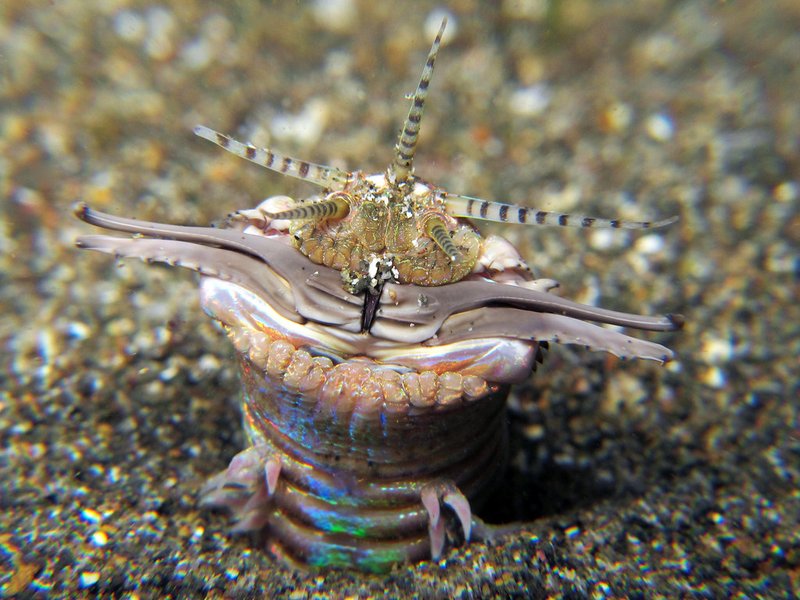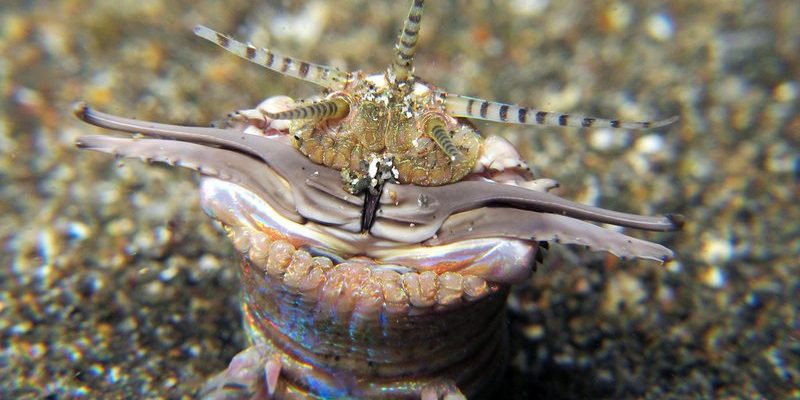
Bobbit worms, or *Eunice aphroditois*, are a type of polychaete worm found in warm waters, mostly living buried in sandy or muddy substrates. With their long, segmented bodies, they can stretch up to 10 feet in length, although they’re usually less than that. Understanding their anatomy isn’t just about knowing what they look like; it’s about grasping how their design makes them expert ambush hunters. So grab a cup of coffee, and let’s break down the fascinating aspects of Bobbit worm anatomy together.
What Does a Bobbit Worm Look Like?
When you first see a Bobbit worm, your eyes might be drawn to its vibrant colors. Ranging from green to brown with hints of blue or red, these worms are not just visually captivating; they’re also uniquely adapted to their environment. Their body is made up of various segments called *metameres*, which play a crucial role in both mobility and flexibility.
Each segment contains parapodia, which are like tiny flaps that help the worm move through the sand and water. The movement of these parapodia is quite graceful, despite the worm’s size. Imagine a snake slithering through the grass; that’s somewhat how Bobbit worms maneuver through their underwater homes. You might be wondering how such a long worm can effectively hunt. The answer lies in their **head region**.
The Head: A Predator’s Tool
At first glance, the head of a Bobbit worm looks somewhat unassuming, but it’s equipped for hunting. Here’s the thing: it sports powerful jaws that can snap shut in the blink of an eye. When prey comes near—think fish, crustaceans, or even smaller worms—the Bobbit worm can quickly emerge from its hiding spot, extending its head to grab its unsuspecting meal.
This ambush strategy is efficient and deadly. The worm relies on its excellent camouflage, blending in with the sea floor while it lies in wait. So, if you’re ever at the beach and see what looks like a hidden shadow in the sand, it might just be a Bobbit worm preparing for its next meal!
How Does Their Ambush Strategy Work?
The ambush technique of a Bobbit worm is nothing short of spectacular. Imagine being able to sit still and then strike with precision, all while remaining hidden. When they sense vibrations or movement in the water—like that of a fish swimming nearby—they react instinctively.
Their body is designed to remain buried beneath the sand, with only a small portion of their head visible. Once they detect movement, they can launch their powerful bite. This quick reaction time is a key to their hunting success; prey has little chance to escape. This design effectively turns the worm into a sudden, fierce predator, underscoring the beauty of evolution in action.
The Role of Sensory Organs
What helps Bobbit worms be such successful ambush predators? Their sensory organs! Located on their heads, these organs are finely tuned to detect changes in their environment. They can sense chemical cues and vibrations, which helps them know when a meal is nearby.
This ability is similar to how a cat might sit and listen for the rustle of a mouse in the grass before pouncing. The sensory organs, combined with their swift attack mechanisms, create a perfect storm for effective hunting.
The Importance of Their Segmented Body
Bobbit worms have a specialized segmented body, making them incredibly adaptable. Each segment operates independently, allowing the worm to twist, turn, and extend as needed. This flexibility isn’t just for movement but also plays a role in their feeding habits.
When a Bobbit worm catches prey, it can use its body to secure its meal tightly while consuming it. This design means that they can effectively deal with prey of various sizes, making them versatile predators in their habitat.
Let me explain it this way: think of their body as a fishing rod—long and flexible, giving them the ability to cast out and reel in various types of fish. This unique anatomical structure allows Bobbit worms not only to hunt but also to thrive in diverse environments.
The Critique on Bobbit Worms
While Bobbit worms are fascinating predators, they do play a pivotal role in the ecosystem. As ambush hunters, they help control populations of smaller creatures, which can prevent overpopulation and help maintain balance in marine environments. However, this does raise questions about their impact on local habitats.
In some cases, their aggressive nature can disrupt local ecosystems if their populations grow unchecked. You might wonder how these creatures fit into the bigger picture, but understanding their role helps highlight the complexity of marine ecosystems and the delicate balance within them.
Breeding and Reproduction of Bobbit Worms
Breeding is another intriguing aspect of Bobbit worm anatomy. They reproduce through a process called *epitoky*, where a part of the worm transforms into a reproductive segment. This means they can produce larvae, which eventually settle into the ocean floor, continuing the life cycle. However, the details of their reproduction can vary based on environmental factors.
When it comes to breeding, it’s like they have a secret life. Only during certain times of the year do they peek out to reproduce, which minimizes the risks from predators. Once again, it’s a brilliant adaptation; their ability to thrive while risking exposure only when necessary shows just how well-crafted their life cycle is.
What Happens After Breeding?
After the larvae hatch, they undergo a series of transformations before they settle to the seafloor. During this time, they float freely in the water column, which means they’re vulnerable to predators. It’s a critical phase in their development, but once they settle and begin growing into adult Bobbit worms, they can become the fierce predators we’ve talked about.
Understanding this life cycle helps us appreciate the resilience and adaptability of Bobbit worms. They’ve got a plan for survival, and it’s intricately linked to their anatomy and behavior.
Bobbit worms are truly remarkable creatures, showcasing how anatomy can design an effective ambush predator. Their unique features, from their specialized heads to their segmented bodies, allow them to thrive in their environment and play a significant role in the underwater ecosystem. Whether you’re a marine biology enthusiast or just someone curious about ocean life, understanding Bobbit worm anatomy gives you a glimpse into the wonders of evolutionary design.
Next time you think about the ocean’s hidden treasures, remember the Bobbit worm and its ambush design. There’s so much more beneath the waves, waiting to amaze us!

